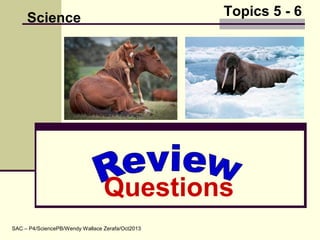Review questions topics 05-06 (q&a)
•Download as PPT, PDF•
1 like•239 views
This document contains review questions and answers about viviparous and oviparous animals. There are four questions that ask to identify the odd one out of a group of animals and explain if they are viviparous or oviparous. The second question contains true/false statements and the third asks to identify which of two animals, fish or penguins, are oviparous parents. The document concludes with stating it is the end.
Report
Share
Report
Share

Recommended
Recommended
More Related Content
More from Wendy Zerafa
More from Wendy Zerafa (8)
Science - Topic 02: Plant Parts - branches and leaves

Science - Topic 02: Plant Parts - branches and leaves
Science - Topic 05: How animals respond to heat and cold

Science - Topic 05: How animals respond to heat and cold
Recently uploaded
Intravital microscopy (IVM) is a powerful tool utilized to study cellular behavior over time and space in vivo. Much of our understanding of cell biology has been accomplished using various in vitro and ex vivo methods; however, these studies do not necessarily reflect the natural dynamics of biological processes. Unlike traditional cell culture or fixed tissue imaging, IVM allows for the ultra-fast high-resolution imaging of cellular processes over time and space and were studied in its natural environment. Real-time visualization of biological processes in the context of an intact organism helps maintain physiological relevance and provide insights into the progression of disease, response to treatments or developmental processes.
In this webinar we give an overview of advanced applications of the IVM system in preclinical research. IVIM technology is a provider of all-in-one intravital microscopy systems and solutions optimized for in vivo imaging of live animal models at sub-micron resolution. The system’s unique features and user-friendly software enables researchers to probe fast dynamic biological processes such as immune cell tracking, cell-cell interaction as well as vascularization and tumor metastasis with exceptional detail. This webinar will also give an overview of IVM being utilized in drug development, offering a view into the intricate interaction between drugs/nanoparticles and tissues in vivo and allows for the evaluation of therapeutic intervention in a variety of tissues and organs. This interdisciplinary collaboration continues to drive the advancements of novel therapeutic strategies.
(May 29th, 2024) Advancements in Intravital Microscopy- Insights for Preclini...

(May 29th, 2024) Advancements in Intravital Microscopy- Insights for Preclini...Scintica Instrumentation
Recently uploaded (20)
ESR_factors_affect-clinic significance-Pathysiology.pptx

ESR_factors_affect-clinic significance-Pathysiology.pptx
erythropoiesis-I_mechanism& clinical significance.pptx

erythropoiesis-I_mechanism& clinical significance.pptx
Earliest Galaxies in the JADES Origins Field: Luminosity Function and Cosmic ...

Earliest Galaxies in the JADES Origins Field: Luminosity Function and Cosmic ...
In silico drugs analogue design: novobiocin analogues.pptx

In silico drugs analogue design: novobiocin analogues.pptx
insect taxonomy importance systematics and classification

insect taxonomy importance systematics and classification
SAMPLING.pptx for analystical chemistry sample techniques

SAMPLING.pptx for analystical chemistry sample techniques
Body fluids_tonicity_dehydration_hypovolemia_hypervolemia.pptx

Body fluids_tonicity_dehydration_hypovolemia_hypervolemia.pptx
Gliese 12 b: A Temperate Earth-sized Planet at 12 pc Ideal for Atmospheric Tr...

Gliese 12 b: A Temperate Earth-sized Planet at 12 pc Ideal for Atmospheric Tr...
PRESENTATION ABOUT PRINCIPLE OF COSMATIC EVALUATION

PRESENTATION ABOUT PRINCIPLE OF COSMATIC EVALUATION
(May 29th, 2024) Advancements in Intravital Microscopy- Insights for Preclini...

(May 29th, 2024) Advancements in Intravital Microscopy- Insights for Preclini...
BLOOD AND BLOOD COMPONENT- introduction to blood physiology

BLOOD AND BLOOD COMPONENT- introduction to blood physiology
Review questions topics 05-06 (q&a)
- 1. Topics 5 - 6 Questions Science SAC – P4/SciencePB/Wendy Wallace Zerafa/Oct2013
- 2. Review Questions SAC – P4/SciencePB/Wendy Wallace Zerafa/Oct2013 Topics 5-6 Q.1 Which is the odd one out. Explain your choice. Answer: chicken Reason: A chicken is oviparous (lays eggs), whilst the horse and the hamster are viviparous (give birth to their young).
- 3. Review Questions SAC – P4/SciencePB/Wendy Wallace Zerafa/Oct2013 Topics 5-6 Q.1 Which is the odd one out. Explain your choice. Answer: fox Reason: A fox is viviparous (gives birth to its young), whilst the frog and the fly are oviparous (lay eggs).
- 4. Review Questions SAC – P4/SciencePB/Wendy Wallace Zerafa/Oct2013 Topics 5-6 Q.1 Which is the odd one out. Explain your choice. Answer: bear Reason: A bear is viviparous (gives birth to its young), whilst the bird and the butterfly are oviparous (lay eggs).
- 5. Review Questions SAC – P4/SciencePB/Wendy Wallace Zerafa/Oct2013 Topics 5-6 Q.1 Which is the odd one out. Explain your choice. Answer: mosquito Reason: A mosquito is oviparous (lays eggs), whilst the meerkat and the monkey are viviparous (give birth to their young).
- 6. Review Questions SAC – P4/SciencePB/Wendy Wallace Zerafa/Oct2013 Topics 5-6 Q. 2 FALSE TRUE FALSE TRUE
- 7. Review Questions SAC – P4/SciencePB/Wendy Wallace Zerafa/Oct2013 Topics 5-6 Q. 3 FISH PENGUINS The fish. The penguin. Both the fish and the penguin are oviparous parents.
- 8. Review Questions SAC – P4/SciencePB/Wendy Wallace Zerafa/Oct2013 Topics 5-6 THE END
